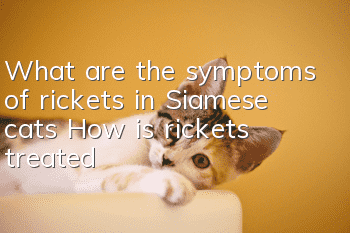What are the symptoms of rickets in Siamese cats? How is rickets treated?

Not every Siamese cat will definitely develop Siamese cat rickets, but all Siamese cats are at risk of the disease. The severity of symptoms and age of onset vary among different individuals, ranging from young to middle-aged Siamese cats. It can occur in any Siamese cat, and some studies have even shown that many Siamese cats with normal limb function can also see milder characteristic changes on radiographic images. As long as the cat carries the Siamese cat gene, the disease may occur at any time in his life.
Siamese cat rickets:
The most common genetic disease in Siamese cats is chondrooskeletal dysplasia, which is also accompanied by complications of respiratory system problems. Siamese cats suffering from chondrooskeletal dysplasia will have their tails become thick, short, stiff, unable to flex, and unable to swing at will; the cat's hind limbs will be significantly short and unable to bend normally, with growths or growths appearing. Lumps, swelling in the joints of the limbs, etc. At the same time, genes associated with bone lesions can also affect the development of cartilage tissue in other parts of the body. The most common one is breathing difficulty due to narrowing of the respiratory tract, which requires surgery to relieve the condition.
Symptoms of rickets in Siamese cats:
1) Siamese cat’s hind limbs are too short and have unusual bends, growths or lumps.
2) Siamese cats have swollen joints in their limbs, and their toes are also deformed due to swollen joints.
3) The hind paws are abnormally thick. If you observe carefully, when the Siamese cat sits upright, the pillow meat of the hind paws cannot touch the ground.
4) The toenails grow abnormally and the pads will be thicker than those of normal Siamese cats.
5) Siamese cats with rickets will also have similar symptoms on their forelimbs, but the symptoms are milder than those on their hind limbs, and they will habitually lift their feet.
Treatment of rickets in Siamese cats:
There is currently no particularly effective treatment for Siamese cat rickets, because it is impossible to change the gene fragment. Treatment mainly uses supportive therapy. Surgical methods can also be used to remove excess exostoses and improve joint activity. Subcutaneous administration of pentosane polysulfate or oral administration of glycosaminoglycan can improve joint flexibility and pain response.
After reading the above content, how much do owners know about Siamese cat rickets? I hope the relevant content provided by the above editor can help all owners.
- How to tell if a cat has a fever without a thermometer
- Causes and treatments of pet cat ear scabies
- Do cats need additional nutritional supplements besides eating cat food? The nutrients cats need every day!
- How to make a cat remember its name and learn to shake hands
- At what age can a cat be dewormed? Teach you step by step how to raise a cat and deworm it!
- Why cats don’t like to be hugged
- What should I do if my cat is frightened and stressed by the hair dryer while taking a bath?
- How to tell if a cat is throwing up hairballs or vomiting
- How to trim a cat's nails
- Your cat’s vision seems to have declined? Be careful when petting your cat!



